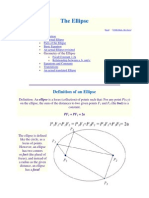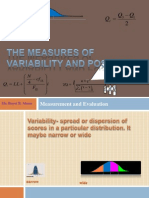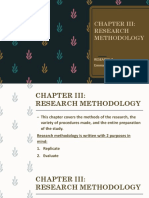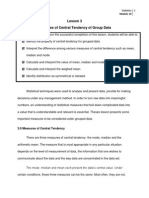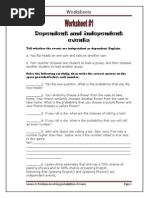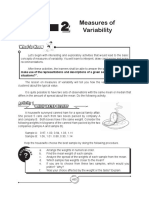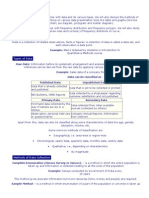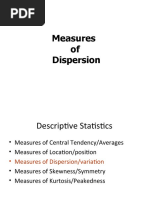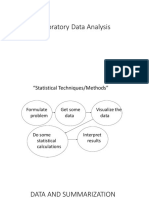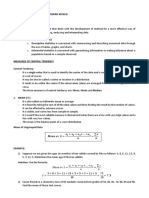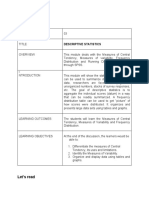0 ratings0% found this document useful (0 votes)
146 viewsEd105 A
Ed105 A
Uploaded by
api-268563289Copyright:
© All Rights Reserved
Available Formats
Download as PPTX, PDF, TXT or read online from Scribd
Ed105 A
Ed105 A
Uploaded by
api-2685632890 ratings0% found this document useful (0 votes)
146 views14 pagesOriginal Title
ed105 a-ppt
Copyright
© © All Rights Reserved
Available Formats
PPTX, PDF, TXT or read online from Scribd
Share this document
Did you find this document useful?
Is this content inappropriate?
Copyright:
© All Rights Reserved
Available Formats
Download as PPTX, PDF, TXT or read online from Scribd
Download as pptx, pdf, or txt
0 ratings0% found this document useful (0 votes)
146 views14 pagesEd105 A
Ed105 A
Uploaded by
api-268563289Copyright:
© All Rights Reserved
Available Formats
Download as PPTX, PDF, TXT or read online from Scribd
Download as pptx, pdf, or txt
You are on page 1of 14
Variability provides a quantitative
measure of the degree to
which scores in a distribution are
spread out or clustered together.
I . Measures of Variability (Dispersion)
-Allow us to summarize our data set
with a single value.
-The 3 main measures of variability:
Range, Variance, and
Standard Deviation.
The Range
The range is the simplest
measure of variability. It is the
difference between the largest
value and the smallest value.
R = H L
where R = Range, H = Highest
value, L = Lowest value
The Variance of Grouped Data (2)
Variance is the average of the square deviation
from the mean. For large quantities, the variance is
computed using frequency distribution with columns
for the midpoint value, the product of the frequency
and midpoint value for each interval; the deviation
and its square; and the product of the frequency and
the squared deviation.
To find variance of a grouped data, use the formula:
_
2 = f(X x)
2
f 1
where; f = class frequency
X = class mark
_
x = class mean
f = total number of frequency
Illustrative Example:
Find the variance of the given data set:
Scores in Second Periodical Test of
I Faith in Mathematics I
Scores Frequency
46 50 1
41 45 10
36 40 10
31 35 16
26 30 9
21 25 4
Scores Frequency
(f)
Class
Mark (X)
fX
_
(X x)
_
(X x)
2
_
f (X x)
2
46 50 1 48 48 13.4 179.56 179.56
41 45 10 43 430 8.4 70.56 705.6
36 40 10 38 380 3.4 11.56 115.6
31 35 16 33 528 -1.6 2.56 40.96
26 30 9 28 252 -6.6 43.56 392.04
21 25 4 23 92 -11.6 134.56 538.24
i = 5 f = 50 fX = 1,730 f(X x)2= 1,972
Mean (x) = fX = 1, 730 = 34.60
f 50
_
2 = f(X x)
2
f 1
2 = 1,972
50 1
2 = 1,972 = 40.2448~40.24
49
Therefore, the variance(2) is 40.24.
Standard Deviation (s)
The standard deviation is considered the best
indicator of the degree of dispersion among the
measures of variability because it represents an
average variability of the distribution. Given the
set of data, the smaller the range, the smaller the
standard deviation, the less spread is the
distribution.
To get the value of the standard deviation (s),
just simply get the square root of the variance
(2):
___
s = 2
Illustrative Example:
Refer to the given previous example. Get the square root of the
given value of variance:
s = 2
s = 40.24
s = 6.34
Therefore, the standard deviation of the Scores in Second
Periodical Test of I Faith in Mathematics I is 6.34.
Glossary of terms
Variability provides a quantitative measure of the degree to
which scores in a distribution are spread out or clustered together.
Range is the simplest measure of variability. It is the difference between
the largest value and the smallest value.
Variance is the average of the square deviation from the mean. For large
quantities, the variance is computed using frequency distribution with
columns for the midpoint value, the product of the frequency and midpoint
value for each interval; the deviation and its square; and the product of
the frequency and the squared deviation.
Standard deviation is considered the best indicator of the degree of
dispersion among the measures of variability because it represents an
average variability of the distribution. Given the set of data, the smaller
the range, the smaller the standard deviation, the less spread is the
distribution.
Canonigo, A. (2012) Statistics, K 12 Facilitators
Guide
Math IV, Project EASE
Amsco_Integrated Algebra, Statistics
www.mathcentre.ac.uk
Pogoso, C., Montana, R, Introductory Statistics
Module_10.pdf
S.Ch4.pdf
Summary
This lesson discussed about measures
of variability of grouped data. This lesson
shows how to solve range, variance and
standard deviation of the given grouped
data using different formulas.
You might also like
- 1.6 - Linear System and Inverse MatrixDocument14 pages1.6 - Linear System and Inverse MatrixABU MASROOR AHMEDNo ratings yet
- Business Statistics A First Course 4th Edition Chapter 1Document11 pagesBusiness Statistics A First Course 4th Edition Chapter 1AvinashRaiNo ratings yet
- Final PPT BalagtasDocument41 pagesFinal PPT Balagtaspemea2008No ratings yet
- 21 Century Lessons: Evaluating ExpressionDocument22 pages21 Century Lessons: Evaluating ExpressionSolomon Dao-as NaganagNo ratings yet
- Leadership and MathematicsDocument25 pagesLeadership and Mathematicskeneth kaundaNo ratings yet
- Soal TIMMSDocument124 pagesSoal TIMMShanah123No ratings yet
- Designing Scoring Rubrics For Your ClassroomDocument19 pagesDesigning Scoring Rubrics For Your Classroomzali2102100% (1)
- Ped 107 Nov 26Document20 pagesPed 107 Nov 26Justin BartolomeNo ratings yet
- Statistics Notes 2019 CertificateDocument87 pagesStatistics Notes 2019 CertificateHamisi WariobaNo ratings yet
- Week 4: Laws of Exponent Multiplication and Division of Polynomia LsDocument14 pagesWeek 4: Laws of Exponent Multiplication and Division of Polynomia LsDenise TalaveraNo ratings yet
- Fe Groupchapter 6 RubricsDocument67 pagesFe Groupchapter 6 RubricsDanielNo ratings yet
- Substitution and Elimination 2Document54 pagesSubstitution and Elimination 2api-318836863No ratings yet
- Gmdss SimulatorDocument6 pagesGmdss SimulatordraNo ratings yet
- Aries PresentationDocument23 pagesAries PresentationAries Gonzales CaraganNo ratings yet
- The Ellipse: Definition of An EllipseDocument14 pagesThe Ellipse: Definition of An EllipseMary Frances DabaNo ratings yet
- Assessment Evaluation in MathematicsDocument6 pagesAssessment Evaluation in MathematicsBethany Faith BatalunaNo ratings yet
- The Scheffé Test and The Tukey TestDocument14 pagesThe Scheffé Test and The Tukey TestAutumn LlorenNo ratings yet
- Chapt 36Document16 pagesChapt 36Ahmet AkgunerNo ratings yet
- Name - Year & Section - DateDocument2 pagesName - Year & Section - DateNoemi Rosario SanchezNo ratings yet
- Central Tendency (Stats)Document89 pagesCentral Tendency (Stats)kutaboys100% (1)
- Rubric DevelopmentDocument16 pagesRubric DevelopmentMaria Flores RamirezNo ratings yet
- Arithmetic MeansDocument15 pagesArithmetic MeansApril Joy LoreteNo ratings yet
- Lesson 11.4: Scatter Plots: Standards: SDP 1.0 and 1.2 Objective: Determine The Correlation of A Scatter PlotDocument14 pagesLesson 11.4: Scatter Plots: Standards: SDP 1.0 and 1.2 Objective: Determine The Correlation of A Scatter PlotRamanand YadavNo ratings yet
- Mean Grouped DataDocument12 pagesMean Grouped DataGerald BajadoNo ratings yet
- Capstone Presentation 2Document22 pagesCapstone Presentation 2api-437398074No ratings yet
- Performance Task 2Document3 pagesPerformance Task 2api-535003994No ratings yet
- Mathematics 10 Quarter 4 Week 3: Interpreting Measure of PositionDocument37 pagesMathematics 10 Quarter 4 Week 3: Interpreting Measure of PositionSherelyn Salanda Alcantara0% (1)
- Alternate Interior Angles Theorem 09112019Document3 pagesAlternate Interior Angles Theorem 09112019PashupatiNo ratings yet
- Finals in Edu 533Document11 pagesFinals in Edu 533ISSUE TVNo ratings yet
- Measures of VariabilityDocument7 pagesMeasures of VariabilityLevi John CayayanNo ratings yet
- Welcome To Our Calculus 1 Subject: Lesson 3Document14 pagesWelcome To Our Calculus 1 Subject: Lesson 3Van LeronNo ratings yet
- Palompon Institute of Technology Palompon, Leyte: FD 502 (Educational Statitics)Document18 pagesPalompon Institute of Technology Palompon, Leyte: FD 502 (Educational Statitics)andersonNo ratings yet
- Marketing Research Study NoteDocument18 pagesMarketing Research Study NoteAaron Pinto100% (1)
- Module Requirement For Abstract AlgebraDocument6 pagesModule Requirement For Abstract AlgebraNimrod CabreraNo ratings yet
- The Measures of VariabilityDocument8 pagesThe Measures of VariabilityBoyet AluanNo ratings yet
- JGBarsana - Statistical TreatmentDocument19 pagesJGBarsana - Statistical TreatmentJayson BarsanaNo ratings yet
- Strategies in Teaching Math in The New NormalDocument36 pagesStrategies in Teaching Math in The New NormalQuerubee Donato DiolulaNo ratings yet
- Measures of VariabilityDocument9 pagesMeasures of VariabilityMartin Ortillana100% (1)
- Representation of Data - Frequency DistributionDocument23 pagesRepresentation of Data - Frequency DistributionNihal AhmadNo ratings yet
- Mode For Grouped Data: Aldrin L. Salibio Maed - MathematicsDocument49 pagesMode For Grouped Data: Aldrin L. Salibio Maed - Mathematicsangeli100% (1)
- Square Root and Cube RootsDocument17 pagesSquare Root and Cube RootsvijayalakshmiramanNo ratings yet
- Central Limit TheormDocument101 pagesCentral Limit TheormGhada SheashaNo ratings yet
- System of Linear Inequalities in Two VariablesDocument20 pagesSystem of Linear Inequalities in Two VariablesAlenie Cornejo ReyesNo ratings yet
- Exploration (AS) : Distance and Midpoint FormulaDocument6 pagesExploration (AS) : Distance and Midpoint FormulaTiffany Joy Lencioco GambalanNo ratings yet
- SkewnessDocument6 pagesSkewnessKrishan Kant MeenaNo ratings yet
- 1.4 Writing Equations of LinesDocument8 pages1.4 Writing Equations of Linesrad58No ratings yet
- Measures of Central Tendency and DispersionDocument64 pagesMeasures of Central Tendency and DispersionWeb Developer OfficialsNo ratings yet
- Complex FunctionsDocument102 pagesComplex FunctionsRajesh100% (2)
- GR 7 DivisibilityDocument10 pagesGR 7 DivisibilityЈелена КукићNo ratings yet
- Percentage Grade6Document24 pagesPercentage Grade6Marissa MenesesNo ratings yet
- Sample VS. Population: in Statistics We Commonly Use The Terms Population and SampleDocument6 pagesSample VS. Population: in Statistics We Commonly Use The Terms Population and SampleLots KieNo ratings yet
- Transformation ProjectDocument20 pagesTransformation Projectapi-288987258No ratings yet
- 9 A 40 D 391Document40 pages9 A 40 D 391Alphar Ann Herrera AgravanteNo ratings yet
- Quarter 2-Module 6: Special Products: Prepared By-Marivic M. YambotDocument27 pagesQuarter 2-Module 6: Special Products: Prepared By-Marivic M. YambotJervin BolisayNo ratings yet
- Research Methodology: Research 2 Emmanuel Paciano M. MabulayDocument53 pagesResearch Methodology: Research 2 Emmanuel Paciano M. MabulayRonnie TolentinoNo ratings yet
- StatisticsDocument24 pagesStatisticsLea Grace GulengNo ratings yet
- Statistics - 2 LGDocument14 pagesStatistics - 2 LGlewilajonathanNo ratings yet
- Measures of Variability.2023Document26 pagesMeasures of Variability.2023leekoodelimNo ratings yet
- INSTRUCTIONS: Provide The Answer and Solution For Each NumberDocument1 pageINSTRUCTIONS: Provide The Answer and Solution For Each Numberapi-268563289No ratings yet
- Lesson 2 Anchor ActivitiesDocument11 pagesLesson 2 Anchor Activitiesapi-268563289No ratings yet
- Lesson 3 BbreakersDocument9 pagesLesson 3 Bbreakersapi-268563289No ratings yet
- Lesson 4Document35 pagesLesson 4api-268563289100% (5)
- Lesson 3 EdtechDocument8 pagesLesson 3 Edtechapi-268563289No ratings yet
- Lesson 2Document7 pagesLesson 2api-268563289No ratings yet
- WorksheetsDocument5 pagesWorksheetsapi-268563289No ratings yet
- Module 11 DocumentDocument6 pagesModule 11 Documentapi-268563289No ratings yet
- Chapter 5Document11 pagesChapter 5api-268563289No ratings yet
- Module 11 TGDocument45 pagesModule 11 TGapi-268563289100% (2)
- Module 10 Teachers GuideDocument72 pagesModule 10 Teachers Guideapi-268563289No ratings yet
- Activity 1 Measures of DispersionDocument4 pagesActivity 1 Measures of Dispersionyt premNo ratings yet
- Measure of VariabilityDocument25 pagesMeasure of VariabilityAshlee MedinoNo ratings yet
- Mathematics Reviewer Part 1Document18 pagesMathematics Reviewer Part 1Yra MontealtoNo ratings yet
- Exemplar Distance Learning LessonDocument4 pagesExemplar Distance Learning Lessonapi-636150180No ratings yet
- Statistics Important QuestionsDocument26 pagesStatistics Important QuestionsAkshit JunejaNo ratings yet
- SD and MADDocument23 pagesSD and MADlyca janeNo ratings yet
- Statistics 11th JEEDocument107 pagesStatistics 11th JEESoumabho PalNo ratings yet
- Quantitative Aids To Decision MakingDocument130 pagesQuantitative Aids To Decision MakingbalakscribdNo ratings yet
- Om 1 Special Topics in Operations Management/ Operations Management Chapter 10: Quality ControlDocument2 pagesOm 1 Special Topics in Operations Management/ Operations Management Chapter 10: Quality ControlRoseanne Binayao LontianNo ratings yet
- Standard Deviation Is Independent of Change in Origin'. Explain The Property of Standard Deviatio - Google SearchDocument1 pageStandard Deviation Is Independent of Change in Origin'. Explain The Property of Standard Deviatio - Google SearchAnsh DangNo ratings yet
- Foundation Notes 2013Document25 pagesFoundation Notes 2013Anonymous wXV066fANo ratings yet
- Measures of DispersionDocument19 pagesMeasures of DispersionTrisha MariehNo ratings yet
- Exercises - Ge 4 Mathematics in The Modern WorldDocument7 pagesExercises - Ge 4 Mathematics in The Modern WorldMervin Jason Nicavera BonsolNo ratings yet
- Anderson PPT Ch03Document55 pagesAnderson PPT Ch03Nguyên HồNo ratings yet
- 86 Stille&Palmstrom On Rock Engineering and Tunnels NordicDocument32 pages86 Stille&Palmstrom On Rock Engineering and Tunnels NordicRonald Cornejo MarmanilloNo ratings yet
- FAU S PSG 0221 Capability CalculationDocument24 pagesFAU S PSG 0221 Capability CalculationHammamiSalahNo ratings yet
- 8614-Assignment-1-ALI FAIZUR REHMAN - ID-0000087678 PDFDocument16 pages8614-Assignment-1-ALI FAIZUR REHMAN - ID-0000087678 PDFAli Faizur RehmanNo ratings yet
- 1 - Measures of Location DispersionDocument20 pages1 - Measures of Location DispersionasvanthNo ratings yet
- Measures of DispersionDocument23 pagesMeasures of DispersionAarushi Sharma75% (4)
- Data Analytics TheoryDocument54 pagesData Analytics TheoryChandra MohanNo ratings yet
- Energy & Buildings: Brenton K. Kreiger, Wil V. Srubar IIIDocument17 pagesEnergy & Buildings: Brenton K. Kreiger, Wil V. Srubar IIIArlen GutierrezNo ratings yet
- LESSON PLAN in Math8Document7 pagesLESSON PLAN in Math8Gracel MoralesNo ratings yet
- Unit 2 PDFDocument53 pagesUnit 2 PDFAnurag VarmaNo ratings yet
- Toaz - Info Ge 4 Topic 2 Statistics PRDocument11 pagesToaz - Info Ge 4 Topic 2 Statistics PRMyname IsNo ratings yet
- G7 Math 7 Exam 4thDocument7 pagesG7 Math 7 Exam 4thMyra Ramirez RamosNo ratings yet
- Module 3 Descriptive Statistics FinalDocument15 pagesModule 3 Descriptive Statistics FinalJordine Umayam100% (1)
- Measures of DispersionDocument46 pagesMeasures of DispersionIqbal Hossain NoyonNo ratings yet
- Six Sigma - Live Lecture 10Document59 pagesSix Sigma - Live Lecture 10Vishwa ChethanNo ratings yet
- MATERI PERTEMUAN KE-8 MENGGAMBARKAN DATA-UKURAN ANGKA Bagian 2Document21 pagesMATERI PERTEMUAN KE-8 MENGGAMBARKAN DATA-UKURAN ANGKA Bagian 2Aldi GustianNo ratings yet
- Measures of DispersionDocument27 pagesMeasures of DispersionSakshi KarichNo ratings yet














